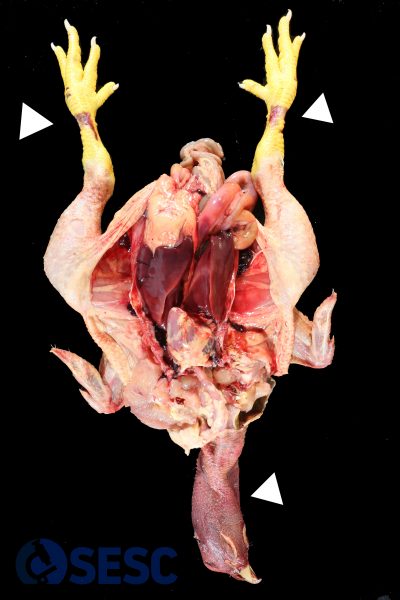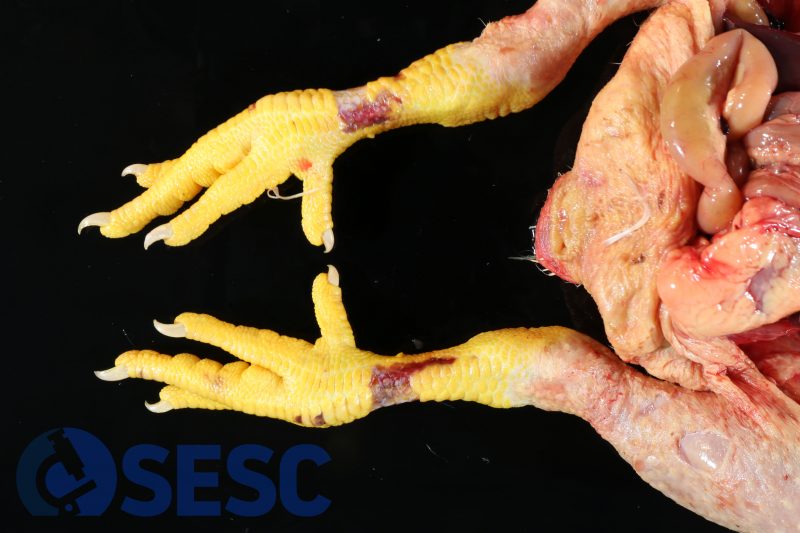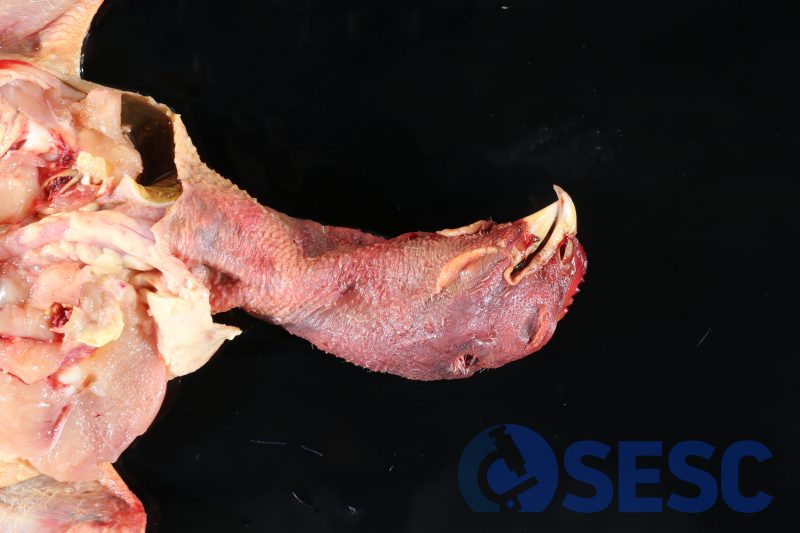Indicators of deficiencies in the poultry stunning process
In a chicken carcass, a marked congestion of the head and neck as well as bilateral ulcerative lesions on the skin of the tarsus-metatarsus were observed.These lesions to the limbs are indicative that the animal has suffered an abrasion with the surface of the hooks due to excessive contact, either by the way they have been hung or by the time they have been suspended prior to death. Congestion in the head and neck indicates that the animal was not properly bled.
Before slaughtering chickens and hens, they are subjected to a stunning process, which often involves the passage of an electric current throughout the animal's body (electrocution). With the right amperage and frequencies, this electrocution can be fatal to animals, but slaughterhouses often avoid these deadly values to improve the quality of the carcass obtained from them, so that stunning is often reversible in many cases (the animal can recover consciousnes) which indicates that it is essential to perform a complete bleed to ensure the death of the animals. All this phases of stunning and sacrifice are done with the animal suspended upside down and held by its legs on hooks. The animal, before it receives the electric discharge in an electric bath will be conscious and the process of being hung upside down holding all its weight on its limbs is stressfull, so the law states that animals can not stay conscious in this position longer than 60 seconds. After stunning and before the animal regains consciousness, the animal has to be bleed (through the incision of the two carotid arteries and the two jugular arteries) which is what will eventually cause the death of the animal. Only once we have made sure that the animal is dead can it then move on to the next stage of the slaughterhouse, which is the scalding tank.
Marked congestion in the head indicates that this animal did not bleed properly and therefore, in a reversible stunning system, there is a risk that the animal will enter the scalding tank alive, which is prohibited by current legislation. However, it cannot be ruled out that the animal died of cardiac arrest before scalding. The presence of abrasions on the limbs, on the other hand, also needs corrective measures to prevent them from recurring.
These deficiencies may be due to, among other things:
- An inadequate size of the hooks in relation to the size of the animals.
- A worker who acts aggressively when placing animals on the hook.
- Lack of a device to allow heavier animals to rest their weight on their chests instead of on their limbs.
- Excessive suspension time before stunning.
- Excessive fluttering or agitation of animals that can be reduced with blue light, curtains that darken the area where the animals are, avoid shrill sounds or, as mentioned earlier, the use of a device where the animal's chest can rest.
- Poorly stunned animal that prolongs fluttering and agitation beyond the bath due to pre-stunning electric shocks, insufficient amperages, or an incorrect height of the electric bath, among other factors.
- Poor bleeding due to poor condition of the knives.
- Insufficient control of bleeding by operators or in other words, lack of a person to review the bleeding by those animals that might escape the knives.
Other indicators of a lack of well-being during the slaughter process are the presence of acute hematomas that we discussed in a previous post.
We would like to thank Dr. Antoni Dalmau of IRTA's Animal Welfare program his contributions and the revision of this entry. (EV)

Chicken carcass with ulcerative lesions in the tarsus-metatarsus and marked congestion in the head and neck.

Details of bilateral ulcerative lesions in the tarsus-metatarsus, indicating that the animal has been in suspension and conscious longer than expected.

Intense congestion in the head and neck indicative of poor bleeding.

